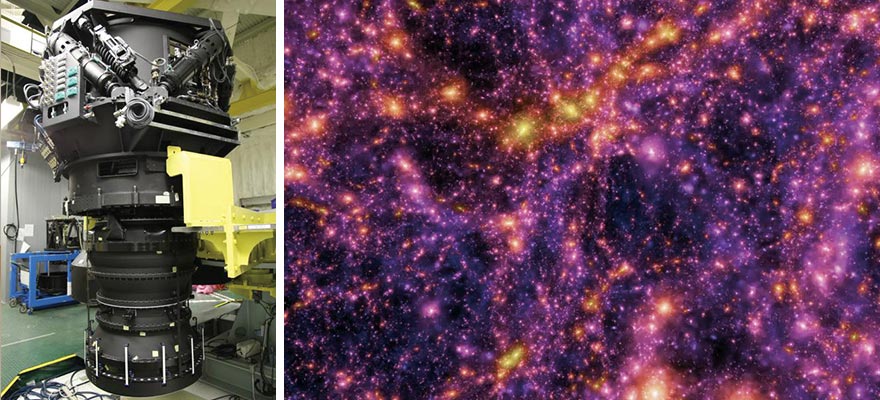Home > Highlighting JAPAN >Highlighting Japan April 2014>Science & Technology
Highlighting JAPAN
Science & Technology
The SuMIRe Project
Momentous, Japan-led dark matter and dark energy research

The SuMIRe Project is a Japanese-led international research project being carried out by the University of Tokyo and headed by Professor Hitoshi Murayama, director of the Kavli Institute for the Physics and Mathematics of the Universe (Kavli IPMU). An acronym of Subaru Measurement of Images and Redshifts, the project aims to investigate the dark matter and dark energy that make up the majority of space, with the hope of explaining the origin and future of the universe.
So, just what are dark matter and dark energy?
You'll of course be familiar with the Milky Way Galaxy. Our Milky Way is surrounded by clusters of hundreds or thousands of other galaxies, and these galaxy clusters are all moving at different speeds. This movement was thought to be the result of the gravitational pull of each galaxy on the others, but years of research has led to the discovery of galaxies moving at speeds that cannot have been generated by the gravity resulting only from the mass of their visible constituents. Thus, scientists proposed the universe is filled with an unknown substance that makes up this invisible mass in space and have come to call that substance 'dark matter.'
Dark energy is thought to be related to the universe's expansion. For years, physicists believed that the universe is still expanding as a result of the Big Bang, but eventually that expansion will slow down due to the interaction between space-time and the material content of the universe. As a result, the universe will either begin to contract, ultimately leading to its collapse, or decelerate to an infinitely low rate of expansion. However, recent research suggests that, far from slowing down, the expansion of the universe is somehow accelerating. 'Dark energy' is the name that has been applied to the force causing this acceleration.
Murayama advocated a massive observation effort to shed light on dark matter and dark energy to solve these riddles of the universe: the SuMIRe Project. From its beginnings at the University of Tokyo, this momentous Japanese science project has grown into an international group as Murayama's proposal gained worldwide recognition, with like-minded research teams around the world asking to participate.
Their base of observation is the Subaru Telescope, located on the summit of Hawaii's Mauna Kea and operated by the National Astronomical Observatory of Japan (NAOJ). The telescope has been fitted with the Hyper Suprime-Cam (HSC) ultra-wide-field camera and the ultra-wide-field Prime Focus Spectrograph (PFS), instruments developed specifically for this project at immense cost, with surveys set to begin in 2014. These instruments will make it possible to obtain, from the earth's surface, imagery deeper and more extensive than that of the Hubble Telescope, with a huge resolution of nearly 900 megapixels and image quality reportedly approaching that of Hubble. Research that was previously expected to take decades now has the potential to see results in the next ten years. This technology will make it possible to survey a 3D 'map' of the universe, which scientists are calling a 'space census.'
Researchers at the University of Tokyo are also hoping this investigation will go beyond the elucidation of dark matter and dark energy, bringing additional benefits by encouraging the next generation of talent through the results achieved by a Japanese-led team of technicians and researchers. Moreover, they're confident the project's technological innovations will both contribute to societal progress and bring economic benefits to Japan. It looks like we can expect great results from the SuMIRe Project over the next ten years.
© 2009 Cabinet Office, Government of Japan






